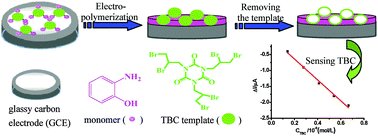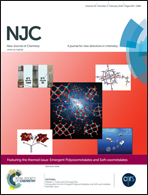Ultrasensitive sensing of tris(2,3-dibromopropyl) isocyanurate based on the synergistic effect of amino and hydroxyl groups of a molecularly imprinted poly(o-aminophenol) film†
Abstract
A facile approach for sensing an emerging persistent organic pollutant, tris(2,3-dibromopropyl) isocyanurate (TBC) is developed based on coupling molecularly imprinting with electro-polymerization of o-aminophenol (OAP), which is an electro-active monomer containing multifunctional groups. The poly-OAP film was deposited in an OAP solution by the potentiodynamic cycling of the potential with and without the template (TBC) on a glassy carbon electrode. Using K3[Fe(CN)6] as an electro-active marker, the properties of the TBC imprinted electrode were investigated by electrochemical measurements. The results showed that the sensor with a low detection limit of 6.64 × 10−11 mol L−1 (S/N = 3) for TBC determination was significantly different from the non-imprinted electrode. By selecting aniline, without a hydroxyl group, as a reference for controlled trials, the limit of detection for the poly-OAP film-coated electrode is ca. 10 times smaller than that of the polyaniline-coated one, and the sensitivity of the poly-OAP film is ca. 2 times higher than that of the polyaniline one. It demonstrates that more binding sites might improve the detection ability of the imprinted sensor.


 Please wait while we load your content...
Please wait while we load your content...